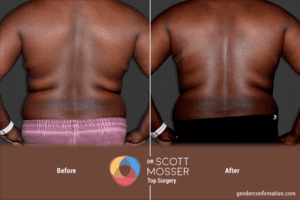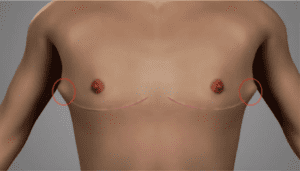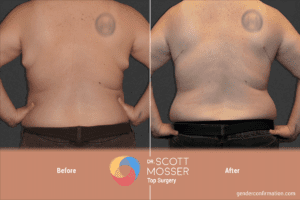Dog Ear Revisions After Plastic Surgery
Medically reviewed by Paul Gonzales on February 16, 2024.
A dog ear is a protrusion of tissue that can develop in areas where an asymmetrical shape or a large amount of tissue is removed. This results in the formation of long or uneven incisions that are closed under tension, leading to a puckering of skin that looks like a dog’s ear. This may be seen with patients who have had tummy tucks (or abdominoplasty), breast lifts, breast reductions, and mastectomies or top surgery. We recommend that patients wait at least 6 months after top surgery for their swelling to subside before they choose to get their dog ears surgically removed in a revision procedure.
This article discusses risk factors for dog ears, how to prevent them, as well as different options for revisions and their associated costs and post-op care instructions. If you would like to know what can be done to prevent dog ears for you or would like to request a procedure to remove them, you can schedule a free, virtual consultation with one of our board-certified surgeons today.
What is a dog ear? Why might I want a revision to remove them?
For top surgery patients, dog ears refer to the puckering or bunching up of excess tissue, usually located at the sides of the chest near the armpit. Rarely, they may also appear near the center of the chest. This concern is most common among patients who have undergone a double incision top surgery and had large amounts of tissue removed.
A dog ear removal is one of the most common reasons for a revision after top surgery. Dog ears can cause aesthetic concerns or discomfort such as dysphoria or chafing against the arms. We accommodate patients’ preferences for pursuing a revision towards dog ears of any size
Before seeking a revision procedure, we recommend that patients wait 6-9 months after top surgery. Oftentimes, dog ears may disappear within the first 3-6 months post-op as swelling subsides (aka ‘false dog ears’). If dog ears are actually a result of excess tissue, they will remain after the recovery period and can be removed in a later revision surgery.
For a visual explanation of why dog ears happen and how they can be removed, you can watch this video, created by Dr. Mosser.
Why do dog ears happen? The risk factors explained
Dog ear formation can happen based on several risk factors:
- Amount of tissue removed: Larger amounts of tissue removed can increase the risk of dog ears. When larger amounts of tissue on the chest are removed, longer incisions need to be pulled closer together. This results in wound closure with excess tension.
- Prior breast reduction procedure: Patients who have undergone a breast reduction before top surgery will likely have excess skin or tissue that puts them at increased risk for dog ears. The incisions may need to be extended laterally or joined near the center, resulting in one long incision across the chest. You can read more about joining incisions at the center of the chest here.
- Age, weight, and skin quality: As we age, our skin becomes less elastic and smooth resulting in loose skin. In addition, dramatic weight loss can leave excess skin behind which may require removal of a larger surface area of skin. Having looser, less elastic skin can increase the likelihood of dog ear formation.
Can dog ears be prevented?
Dog ears cannot always be prevented. For some patients, not all excess skin can be removed in the first surgery, making dog ears almost a certainty. For patients who have less excess skin that needs to be removed, the chances of dog ears may be lower. Ways to considerably minimize the chances of having dog ears in top surgery include:
- Incision length: Having a slightly longer incision, which may extend further towards the back or joined in the center of the chest may prevent dog ear formation
- Patient compliance: Following your top surgeon’s post-op care instructions is very important to minimize the risk of dog ears.
- Weight: The more tissue removed during surgery, the higher the likelihood of patients developing dog ears. Significant weight loss, which leads to excess or loose skin can also contribute to dog ear formation due to the need for more skin removal. Maintaining a healthy body weight before surgery is recommended to reduce these risks.
How are dog ears treated?
While some dog ears may resolve spontaneously, dog ears are generally treated with a revision procedure after top surgery. It is recommended to wait 6-9 months after top surgery before considering a dog ear revision to allow for any swelling to resolve. The amount of excess tissue left behind will help determine the appropriate type of revision procedure performed:
- Liposuction: This procedure can remove any excess fat, but will not affect removing excess skin. Depending on the remaining excess tissue, this procedure may limit the amount of tissue removed.
- Excision under local anesthesia: Dog ears less than 5 inches in length may be removed under local anesthesia. This means that the area will be injected with a numbing solution and the patient will be awake during the procedure. If preferred, this can also be done under general anesthesia.
- Excision under general anesthesia: Some sedation might be required if the dog ears are 5 inches or more in length. After this revision, the contour of the incision is typically close to perfect. The easiest way to see the treatment is by watching this video on dog ears that Dr. Mosser has created.
Dog ear revision surgery: before and after photos
Recovering from a dog ear revision
- Recovery from a dog ear revision is generally easier than recovering from a top surgery procedure since less tissue is removed. Pain is typically minimal and can be managed with over-the-counter medications.
- We encourage patients to take up walking after the operation and avoid strenuous activity until 6 weeks have passed.
- Drains are usually not required unless a larger amount of tissue is removed.
- Patients may opt for an earlier post-op appointment (after 3 days) to remove bandages and can usually shower after the incisions have been assessed.
- Swelling is still expected so a post-op binder may need to be worn. Some surgeons will also recommend that their patients follow a low-sodium diet to minimize swelling.
- Keeping the incisions clean can minimize infections that may delay wound healing. Contact your surgeon if any redness, swelling or warmth is observed.
- Scar care treatments and scar massage can begin 3 weeks after the procedure.
Cost of dog ear revision
Patients who have successfully had their top surgery covered by insurance may also typically have the revision covered. For out-of-pocket patients who initially had their top surgery at GCC, surgeons’ fees for revisions may be waived if scheduled within one year of the initial surgery. However, other fees such as those for the facility and anesthesiologist are not waived and must be paid.
Dog ears in conclusion
- Dog ears are sometimes seen after a double incision top surgery when large amounts of tissue are removed.
- You can talk to a surgeon in a free, virtual consultation about how to minimize, prevent or remove dog ears based on your anatomy.
- Since some dog ears may resolve spontaneously, it is recommended to wait 6 to 9 months after top surgery to determine if a revision is necessary.
- Most dog ear revisions are accomplished by surgically removing the excess tissue under anesthesia, depending on how much tissue is present.
- Patients who get their top surgery covered by insurance have a good chance of getting their revision procedures covered as well.
- You can watch this animated video to learn more about dog ears in detail.
Sources
- Kang, AS, Kang, KS. A Systematic Review of Cutaneous Dog Ear Deformity: A Management Algorithm. Plastic and Reconstructive Surgery – Global Open 8(9):p e3102, September 2020. | DOI: 10.1097/GOX.0000000000003102







